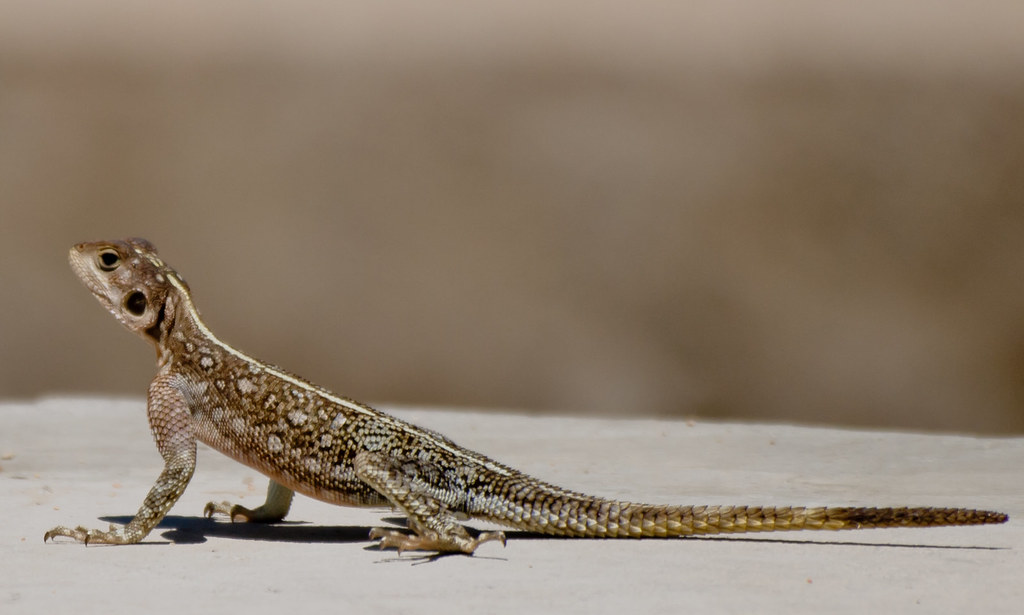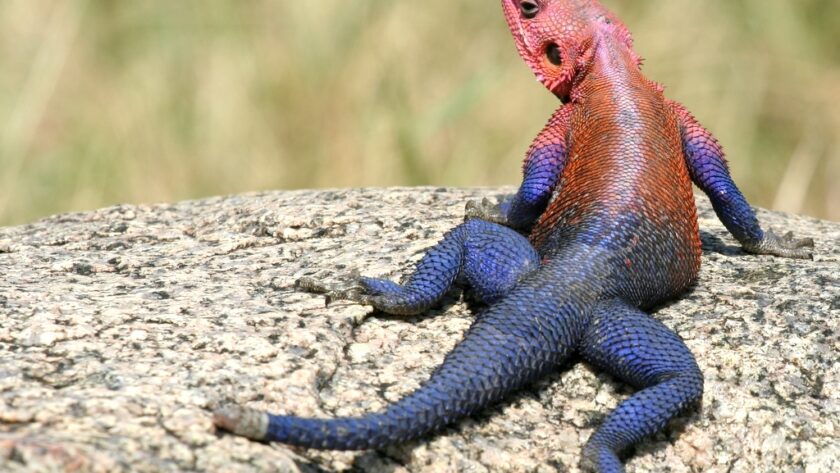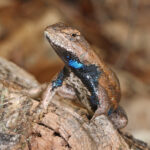Agama lizards are an ancient species, with records of their existence dating back to the time of the Pharaohs! Despite being around for so long, these lizards still have a lot of secrets and surprises that can make them tricky to care for.
In this article, we’ll provide you with all the essential tips for keeping your agama lizard happy and healthy. We’ll cover topics like diet, housing, handling, cleaning, common health problems and behavioral issues as well as breeding.
So read on to start learning everything you need to know about agama lizard care!
Table of Contents
Agama Lizard Diet

A balanced diet is key to keeping your reptile healthy and happy! When it comes to agama lizards, there are certain staple foods that you should incorporate into their diet. These include things like crickets, mealworms, or wax worms.
It’s also important to feed them on a regular schedule – this will help keep them in optimal health. It’s best to feed your agama lizard three times a week with an occasional snack thrown into the mix. To ensure they stay healthy and active, make sure you vary what you’re feeding them on different days of the week.
This way, they can get all the essential vitamins and minerals they need from different sources instead of having the same thing every day. Additionally, avoid overfeeding as this can cause obesity in these species, which could lead to other health problems down the line.
Agama Lizard Housing
Having the right home for your scaly friend can make all the difference in their overall health and happiness.
Here are four key elements you’ll want to consider when setting up your pet’s home:
- Enclosure size – An adult agama lizard should have at least a 30-gallon terrarium. Make sure it’s tall enough so they can climb and explore!
- Temperature regulation – To keep them healthy, agama lizards need both a warm side and cool side of their enclosure. The temperatures should range from 75-90°F on the warm side and 65-75°F on the cool side.
- Substrate – Agamas love to dig and burrow, so provide a substrate that will allow them to do this. Use sand or soil with some peat moss mixed in for humidity control.
- Lighting & Decorations – Natural sunlight is best, but if you don’t have access to this, consider using artificial lighting such as LED grow lights or fluorescent bulbs that mimic natural light cycles for 12 hours per day. Additionally, decorate their enclosure with branches or logs for climbing and other decorations that promote exploration, like plants and hides!
Having a safe environment with plenty of room to move around will ensure your agama lizard has everything they need to stay healthy and happy!
Agama Lizard: Handling
Handling agamas can be a lot of fun, but it’s important to do it safely. In fact, 97% of reptile owners handle their pet at least once a week!
Before you pick up your agama, make sure the temperature in the room is regulated properly. This will help regulate your agama’s body temperature and prevent them from getting too cold or hot while you’re handling them.
It’s also important to take time to socialize with your agama so they become comfortable with being handled. Start small by lightly touching them every day for a few minutes until they become more trusting of you. Once they are used to being handled, you can start picking them up and allowing them to explore around while in your hands.
Always make sure to offer plenty of support when holding your agama and never squeeze them too tightly as this could stress or injure them. With these tips in mind, you’ll be able to enjoy handling your pet without worrying about safety issues!
Agama Lizard: Cleaning
Keeping your agama’s habitat clean is key to their health and wellbeing, so make sure you clean it regularly!
The size of the tank and bedding selection are two important factors to consider when cleaning. In general, a tank for an adult agama should be at least 20 gallons while juvenile lizards can do well in 10 gallon tanks.
For bedding, use terrarium liners like reptile carpet or paper towels which help keep the tank dry and easy to clean.
To keep your lizard healthy and safe from parasites, make sure you spot-clean the enclosure daily by removing any waste or debris that has accumulated. Also, check for mold growth as this could cause respiratory infections in your pet lizard.
Once a week give the entire enclosure a thorough cleaning with warm water without soap or detergent products. This will help remove any bacteria build up that could harm your pet lizard over time.
Agama Lizard Care: Common Health Problems
It’s important to be aware of common health problems that can affect your pet, so you can catch any issues early and nip them in the bud. Here are a few essential tips to keep your agama lizard healthy:
- Make sure to provide a proper temperature gradient for your agama lizard with temperatures ranging from 80-90°F during the day and 70-75°F at night. Provide basking spots near the warm end of their environment.
- Regularly inspect your pet for any signs of parasites like mites or ticks. If you notice any parasites, treat them as soon as possible with an appropriate anti-parasite medication recommended by your veterinarian.
By following these tips, you’ll be able to help ensure that your beloved pet remains happy and healthy!
Agama Lizard: Behavioral Issues
Behavioral issues can be tricky to manage, but with the right guidance and patience, you can help your pet thrive!
Agama lizards are social creatures, so it’s important to provide an enclosure that is large enough for them to feel comfortable. If the environment is too small or doesn’t offer enough opportunities for physical activity, your lizard could become stressed and potentially exhibit aggressive behavior towards other animals in its enclosure.
In addition, agama lizards need plenty of time outside of their enclosure in order to explore and interact with their environment. By providing them a safe area with adequate space for roaming around and socializing with other pets, they will have an opportunity to express natural behaviors without becoming defensive or aggressive.
Additionally, make sure to provide toys and items that stimulate their senses like rocks or logs that they can climb on for enrichment.
With regular monitoring of your pet’s health and behavior as well as consistent interactions between you two, you can ensure a happy home for your agama lizard!
Agama Lizard: Breeding
When it comes to breeding agama lizards, understanding their complex needs is key for successful procreation. Like an intricate puzzle, with the right pieces in place, success will surely follow.
Incubation techniques and temperature control are two fundamental elements for successful breeding. Temperature plays a crucial role in incubation; having the right environment can be the difference between a healthy hatchling or one that doesn’t survive. To ensure success during incubation, temperatures should remain consistent and never exceed 80 degrees Fahrenheit (26.5 Celsius). A reptile thermostat can help you maintain precise temperatures during the entire process.
Once proper temperature is achieved, humidity should also be monitored carefully as this greatly affects egg development and hatching times. It’s recommended to provide a moist environment within 55-65% humidity levels throughout incubation until eggs start to hatch.
During hatching, however, it’s important to lower humidity levels down below 50% so that your baby lizards have enough oxygen available while coming out of their shells.
With these tips in mind, you’ll be well on your way towards creating a safe and comfortable home for your agama lizards to breed successfully!
Frequently Asked Questions
How long do Agama Lizards typically live?
As a pet, agama lizards can make fascinating and enjoyable companions. They typically live for 6-10 years when provided with proper care.
To ensure your agama lizard lives a happy and healthy life, it’s important to understand their dietary needs and habitat requirements. Having the right diet and environment will help your agama lizard stay active and healthy while living its best life!
What type of environment do Agama Lizards prefer?
You may not know it, but you and agama lizards have something in common – you both prefer an environment with a certain temperature range and humidity levels.
Agama lizards are reptiles that need specific conditions to thrive. They need temperatures between 70-85 degrees Fahrenheit and humidity levels of around 50-55%. If the environment is too hot or humid, they can become stressed and won’t thrive.
So, if you’re thinking about getting an agama lizard as a pet, make sure to provide them with the right environment so they can live their best life!
Are Agama Lizards easy to care for?
Caring for an agama lizard is not difficult, although it does require some knowledge and dedication.
Temperature maintenance is essential to their health; the enclosure should be kept at a temperature between 75-85 degrees Fahrenheit with a basking area of 95-100 degrees Fahrenheit.
Additionally, the size of the enclosure should accommodate all of your pet’s needs; it should be large enough for them to move around comfortably and have plenty of room to explore.
With proper care and attention, agama lizards can make great pets that bring joy to their owners.
What type of food do Agama Lizards eat?
You may be wondering what type of food your agama lizard should be eating – and the answer is variety!
You’ll want to make sure that you’re providing a good mix of insects, fresh fruits, vegetables, and other small animals like crickets or mealworms.
Make sure to provide enough dietary variety for your pet to stay healthy and strong.
Additionally, ensure that the temperature of the enclosure is right for their diet; colder temperatures can slow down digestion while warm temperatures can help speed it up.
With the right diet and enclosure conditions, your agama lizard will be living its best life!
Is it safe to handle Agama Lizards?
Handling agama lizards requires following strict protocols and ensuring the enclosure is kept clean. It’s generally safe to handle them, but it’s best to do so with caution.
Make sure you wash your hands before and after handling, as this will help prevent the spread of any bacteria or parasites. Also, never pick up an agama lizard from above; instead, approach it from the side and use both hands when lifting it out of the enclosure.
If done properly and with care, handling agama lizards can be a rewarding experience for both you and your reptile companion.
Conclusion
You’ve now learned the essentials of agama lizard care! With the right diet, housing, handling, and cleaning, your agama will stay happy and healthy.
Remember to keep an eye out for common health problems and behavioral issues. Keeping these tips in mind will ensure you’re providing quality care and that your lizard is living its best life!
And if you’re up for a challenge, try breeding them – it’s like watching a beautiful flower bloom before your eyes.
So take a deep breath, relax, and enjoy this amazing creature – they really can bring joy like no other!




